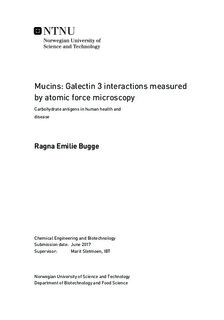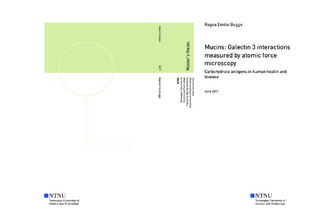| dc.description.abstract | Galectins are a family of widely distributed sugar-binding proteins characterized by a specificity for β-galactosides. These lectins are assumed to be involved in diverse biological phenomena critical for multicellular organisms, and despite the recognized importance of this, there is a lack of information concerning the mechanisms underlying their assumed functions.
An improved understanding of the physiological roles of the different members of the galectin family requires an improved understanding of their sugar-binding specify. The Galectin 3 (Gal3) is known to bind the human Mucin1 with T glycans (MUC1-T), but we have preliminary data from an unpublished study at King s Collage London, indicating that it might bind MUC1 with ST glycans (MUC1-ST) as well. Gal3 inter- action with MUC1-ST, MUC1-T, MUC1 with Tn glycans (MUC1-Tn), and MUC1 with no glycans (MUC1-Naked) were investigated by atomic force microscopy (AFM). Interaction events were observed between MUC1-ST and Gal3, similar to those between MUC1-T and Gal3. These new findings could have implications of the understanding of the role of Gal3 and MUC1 for cancer progression and treatment. However, since some interaction events were observed also for the MUC1-Tn interaction with Gal3 and the MUC1-Naked interaction with Gal3, it can at this stage not be ruled out that the observed interactions between MUC1-ST and Gal3 are non-specific.
Interactions between MUC1-ST and Gal3 were observed at a frequency of 20.8% ±0.6, while interactions between MUC1-T and Gal3 were observed at a frequency of 12% ±6. Interactions between Gal3 and MUC1-Tn were observed at a frequency of 5% ±1, while interactions between Gal3 and MUC-Naked were observed at a frequency of 10% ±3. MUC1-Tn and MUC1-Naked were both used as negative controls.
Further it was showed that a dynamic force spectroscopic analysis suggested an energy landscape for interaction between Gal3 and MUC1-ST, with binding strengths from 40 pN to 80 pN at a loading rate interval of 1128-12512 pN/s. By utilizing the Bell-Evans model, a single energy barrier was identified at xβ =0.21 nm, and a mean dissociation rate was estimated to be kof f =8 s−1, corresponding to a lifetime of τ0=0.125 s. Similar parameters were also obtained from interactions between Gal3 and MUC1-T, which exhibited an energy landscape with strengths ranging from 33 pN to 80 pN at a loading rate interval of 787-6962 pN/s. Here, a single energy barrier was identified at xβ =0.20 nm, and a mean dissociation rate was estimated to be kof f =4 s−1, corresponding to a lifetime of τ0=0.25 s.
Comparison between the data obtained from AFM and data obtained from optical tweezer (OT) in a parallel experiment conducted by another master student, Øystein Haug, revealed a similar linear relationship between most probable rupture force and loading rate for interactions between Gal3 and MUC1. Based on this, a new xβ was estimated to be 0.15 nm.
Implementation of new models for dynamic force spectroscopy analysis would provide more precise estimate of the parameters. Studies on a cellular level could confirm or reject the specificity of the interaction between MUC1-ST and Gal3, and the intracellular mechanisms they might set off. | |

